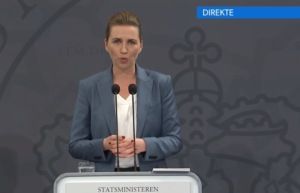Opinion
Opinion: PM’s heroics during Coronavirus Crisis bode well for climate ambition
Paul Holmbeck
This article is more than 5 years old.

Mette Frederiksen will negotiate for an EU budget and recovery fund that prioritise the climate (photo: screenshot)
While I share fears that the corona pandemic will put necessary climate action on the back-burner, I am seeing something different and hopeful in Denmark.
One thing is the rising momentum behind demands from Parliament that the government’s next round of economic stimuli should be investments in climate solutions: more renewable energy, sustainable infrastructure, and energy efficiency in homes and public buildings etc.
But equally uplifting is witnessing genuine political leadership during the Coronavirus Crisis that demonstrates most of the qualities necessary to confront the climate emergency. Before many of us dared to hope that our prime minister, and her government, could lead us through the climate crisis. Now we know that she can.
PM’s sense of urgency
Mette Frederiksen has created a deep, shared sense of urgency. She has communicated clearly about both the threat we are facing and the actions that must be taken.
She has acted decisively, quickly, and with resolve, showing a willingness to invest heavily, here and now, in confronting the crisis.
There is no more ‘business as usual’. Frederiksen has placed demands on business leaders in which goals set by political leaders are non-negotiable, while actions are negotiated so change can happen quickly.
She has taken science and expertise seriously. She has taken political responsibility when the path is not clear and outcomes are uncertain. This is the definition of courage.
This ‘whatever it takes’ determination, and the prime minister’s words at a recent press conference, can be a mantra for leaders in the climate crisis: “Better to do too much than too little. Better to act too soon than too late.”
Directly appealing to us
Frederiksen has made a direct appeal to our community spirit and spoken directly to all of us – about personal responsibility and the necessity to change daily habits that seem as natural as breathing air. In a crisis, be it corona or climate, no-one should be uncertain as to whether they have a role to play or what that role is.
Amid the fears and loss in a crisis, good leadership also awakens hope through a focus on what is worth living for. My favourite image of our PM is not from the press conferences, but a film of her together with her daughter, washing dishes, and singing along to the national corona sing-along on TV.
This same momentum can be created to meet the climate crisis. The ambitious goals in Denmark for reducing climate emissions by 70 percent in 2030 are possible if the same leadership steps up to the podium: decisive action, respect for science, political courage, willingness to invest, and the ability to create a sense of urgency and purpose, mobilising both business and citizens.
The right stuff
Yes, the climate crisis requires solutions that are more complex and more long-term. But Frederiksen, and some other leaders across the globe, have shown they have the right stuff for the climate challenge. They have created a call for action against an invisible yet devastating threat. And we can hope that protecting our children’s future can be at least as motivating as protecting our elderly citizens.
Some leaders have also demonstrated – and awakened in others – the perseverance and robustness that we will need during our transformation, when it will not be about ‘getting back to normal’ as soon as possible, but about creating a new normal and maintaining new norms.
The task at hand will not be getting back to ‘business as usual’, but about building new business models and forming the structural basis for sustainable human existence on our little planet.

About
Paul Holmbeck
American-born Paul Holmbeck advises leaders in government, business and NGOs in policy development and public affairs – primarily in the area of climate and sustainable agriculture and food policy. Over the last 25 years he has played a leading role in making Denmark a world leader in organic food sales and policy as an executive at Organic Denmark. He lives in Aarhus.










































